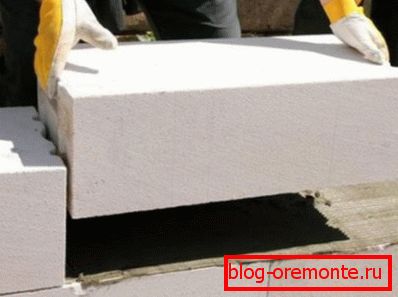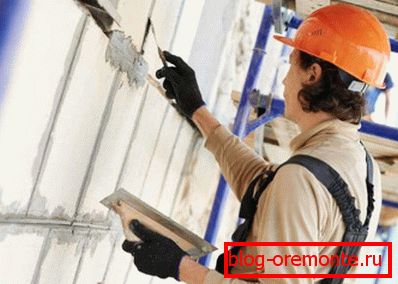Glue for aerated concrete: the main types and calculation of
If you have decided to build a house of aerated concrete blocks, then you will certainly have a question about what kind of mortar should be used to create high-quality and durable masonry walls of such material? In fact, for the production of such a construction work, the usual glue for aerated concrete is used, and in cold time, it has excellent moisture and frost-resistant characteristics.
This kind of adhesive mass is intended for laying houses of gas and foam concrete, as well as other materials with a high level of water absorption. In addition, this adhesive can be used as a putty for leveling the surface.

Types of adhesive mixtures
The answer to the question of how to glue aerated concrete can be an adhesive composition of two types:
- Gray. This kind of tool is suitable for the production of construction and repair work at any time of the year. Winter gray glue contains in its composition antifreeze components that allow you to work with such material at a temperature of at least -10 degrees;
- White. Such a composition can only be used in the summer. Portland cement, which is a part of the glue for white aerated concrete, makes the mortar completely identical in color to the masonry material, which saves on finishing.
Winter construction

If the construction of the masonry of aerated concrete is planned to be done in winter at a temperature of +50 With and below, then you should use a winter frost-resistant solution.
Note! Despite the presence of frost-resistant additives in the composition of this adhesive mass, this adhesive still has temperature limitations. These tools can be used at temperatures from -10 degrees and above.
The features of this type of solution include the following properties:
- The presence of antifreeze components;
- Gray оттенок;
- Possibility of use for exterior and interior;
- Interferes with emergence of cold bridges;
- Minimizes heat loss;
- Resistant to environmental influences;
- Plastic, which provides ease of application;
- Moisture resistant;
- Not afraid of the cold;
- Environmentally safe;
- Relatively low price;
- The use of adhesive solution instead of cement-sand mixture allows to reduce the thickness of the joint by several times, which almost completely eliminates the possibility of creating uneven masonry;
- Thin seams increase the strength of the whole structure;
- The adhesive consumption for aerated concrete per m3 is approximately 25 kg.

In addition to the recommendations, which contains instructions for the use of this kind of mortar for cellular sides, you should know:
- Storage of the bag with a dry mix should be carried out in a dry, heated room;
- Mix the solution with water should also be in a heated room;
- Water to be added to the dry mix should be at a temperature of up to + 60 degrees;
- The temperature of the adhesive mass should not be less than +10 degrees;
- The building block should not be frozen or covered with snow;
- Use the finished winter mixture should be within half an hour after its preparation.
Calculating the amount of mortar for masonry
The consumption rate of glue for aerated concrete is 1.5-1.6 kg of dry mixture per 1 square meter. m. with a layer thickness of 1 mm.
Note! These figures are true and fair only in conditions of application on a perfectly flat, smooth base.
The answer to the question of how much adhesive is needed for aerated concrete is about 15-30 kg per cubic meter. m. of material.
On average, it turns out that a bag or 25 kg of adhesive is spent on 1 cubic meter of building material. But this is all theoretical information.

In reality, when you put the gas-blocks with your own hands, you can be sure that the laying of 1 cubic meter will require about 1.5 bags or 37-38 kg of the mixture.
The reasons for such a large difference between the practical and theoretical values, which gives the calculation of the adhesive for aerated concrete, can be:
- The qualifications and experience of the master;
- The state of the product (evenness of the surface, the presence of defects);
- The number of layers of the mixture;
- Weather.
Council Different companies producing adhesive mixtures give different recommendations regarding the application of the composition and layer thickness. Therefore, before proceeding with the mixing of the composition, carefully read the instructions and clarify what the adhesive consumption for aerated concrete per 1m2 is indicated by the manufacturer.
Recommendations that will allow to adhere to the calculation

In the process of laying blocks of cellular concrete, it is important to act on technology.
This will provide an opportunity not only to reduce the waste of glue mass, but also to prevent its premature seizure:
- Construction works recommended at a temperature not lower than +50 WITH;
- Periodically stir the adhesive mass to ensure uniformity of the composition;
- The installation of the block must be carried out within 15 minutes after application, and the correction of the layer thickness within 3 minutes;
- The useful life of such a mixture is not more than 2 hours;
- Excess composition protruding on the sides should be removed with a trowel;
Note! The negative temperature significantly reduces this period.
- Masonry in the winter time requires not only the addition of cold-resistant additives, but also careful control of the thickness and filling of the seam;
- In the process of work it is necessary to exclude the ingress of glue on the skin or in the eyes. The best option would be to use protective clothing and building gloves.
Note! The laying of aerated concrete, constructed in accordance with these recommendations, will allow you to create strong and reliable walls and partitions. And in order to make a hole in such a construction or to cut a hole, it is necessary to use such methods as cutting reinforced concrete with diamond circles and diamond drilling of holes in concrete.
Finally

The use of a specialized adhesive composition for the construction of masonry of gas blocks, is a great opportunity to create a simple and reliable design and at the same time minimize the seams between the piece materials.
Such solutions have excellent cold-resistant performance, which guarantees warmth and comfort in a building constructed using these building materials. A video in this article will reveal to you even more subtleties of the choice of glue for gas blocks.